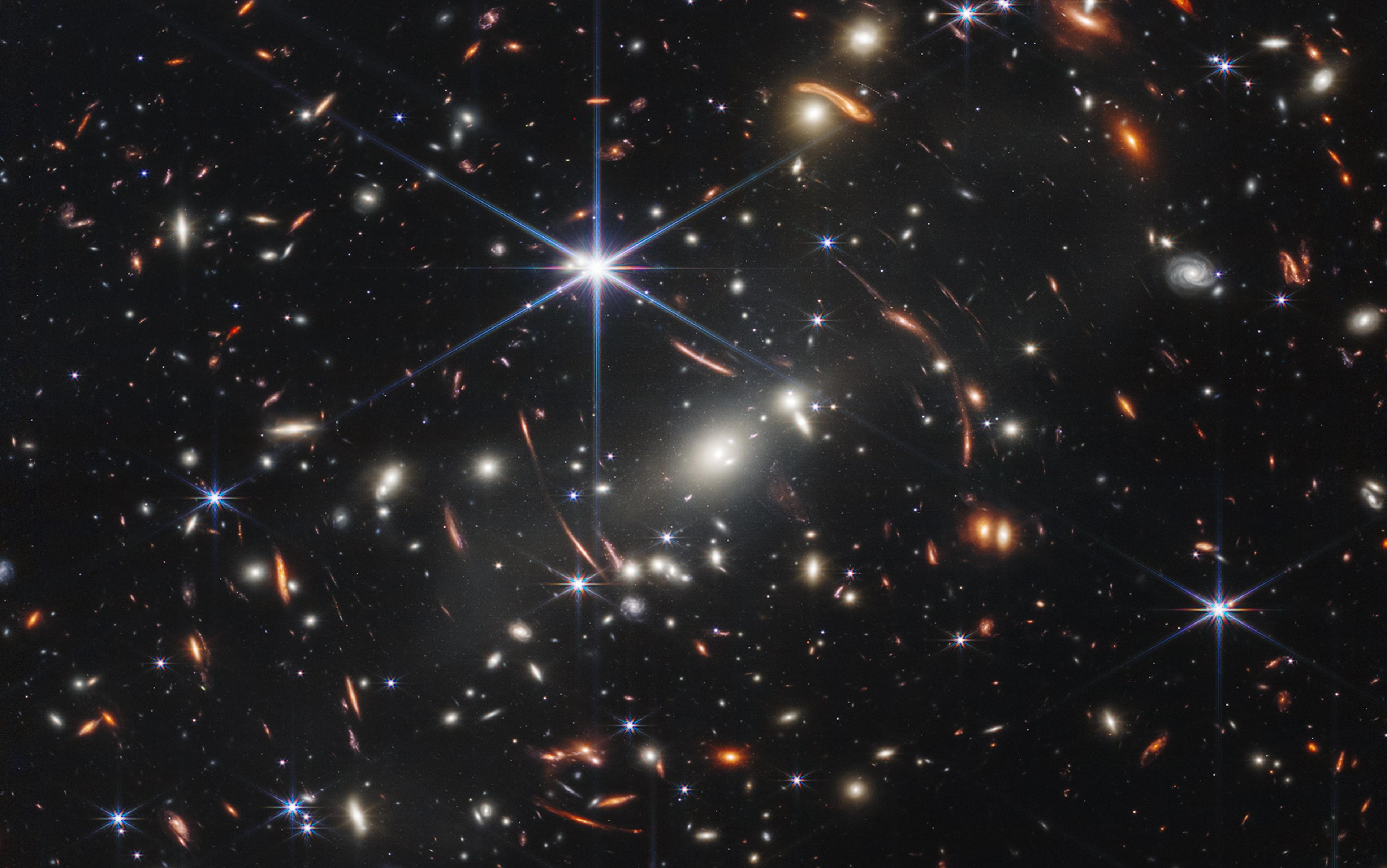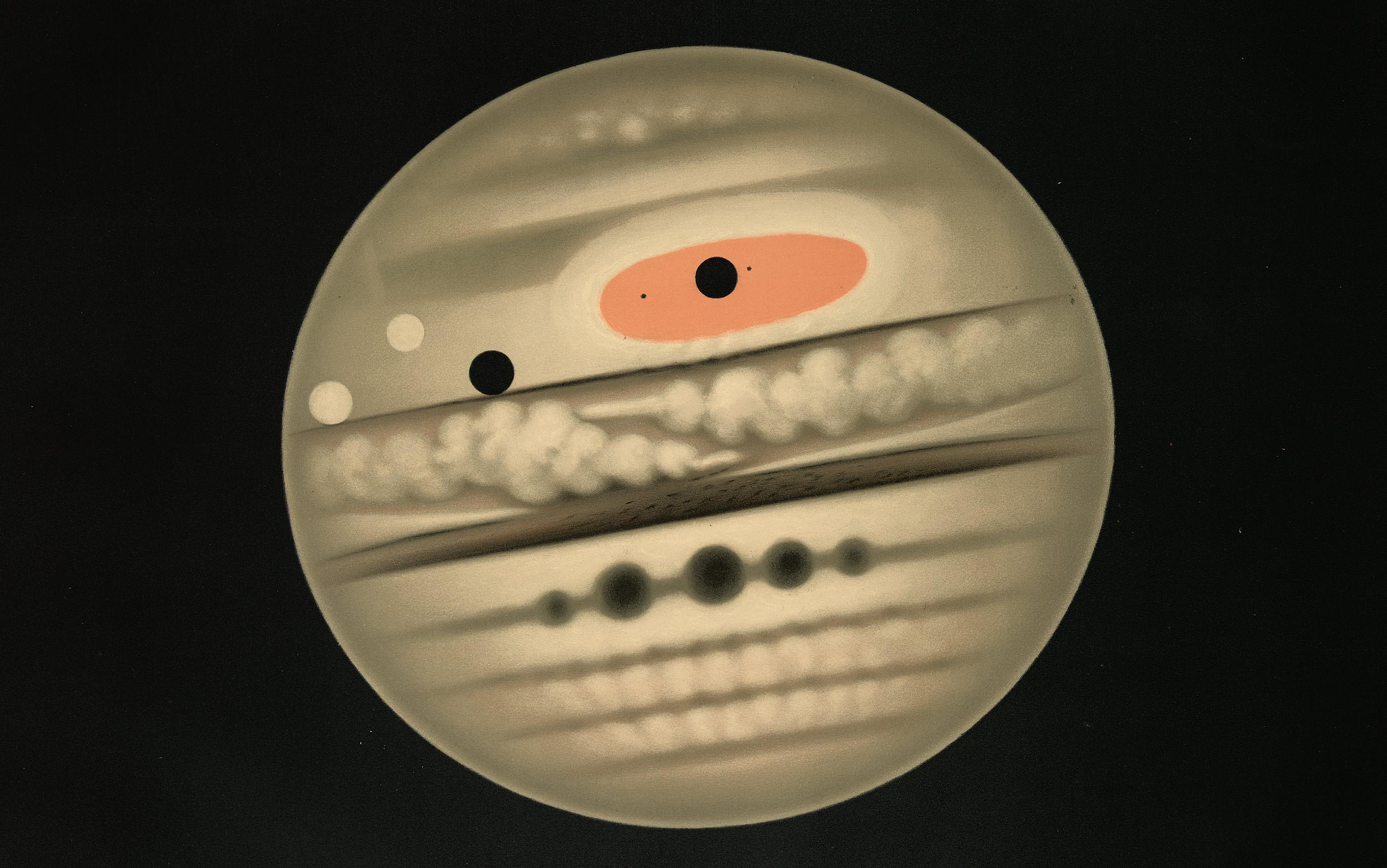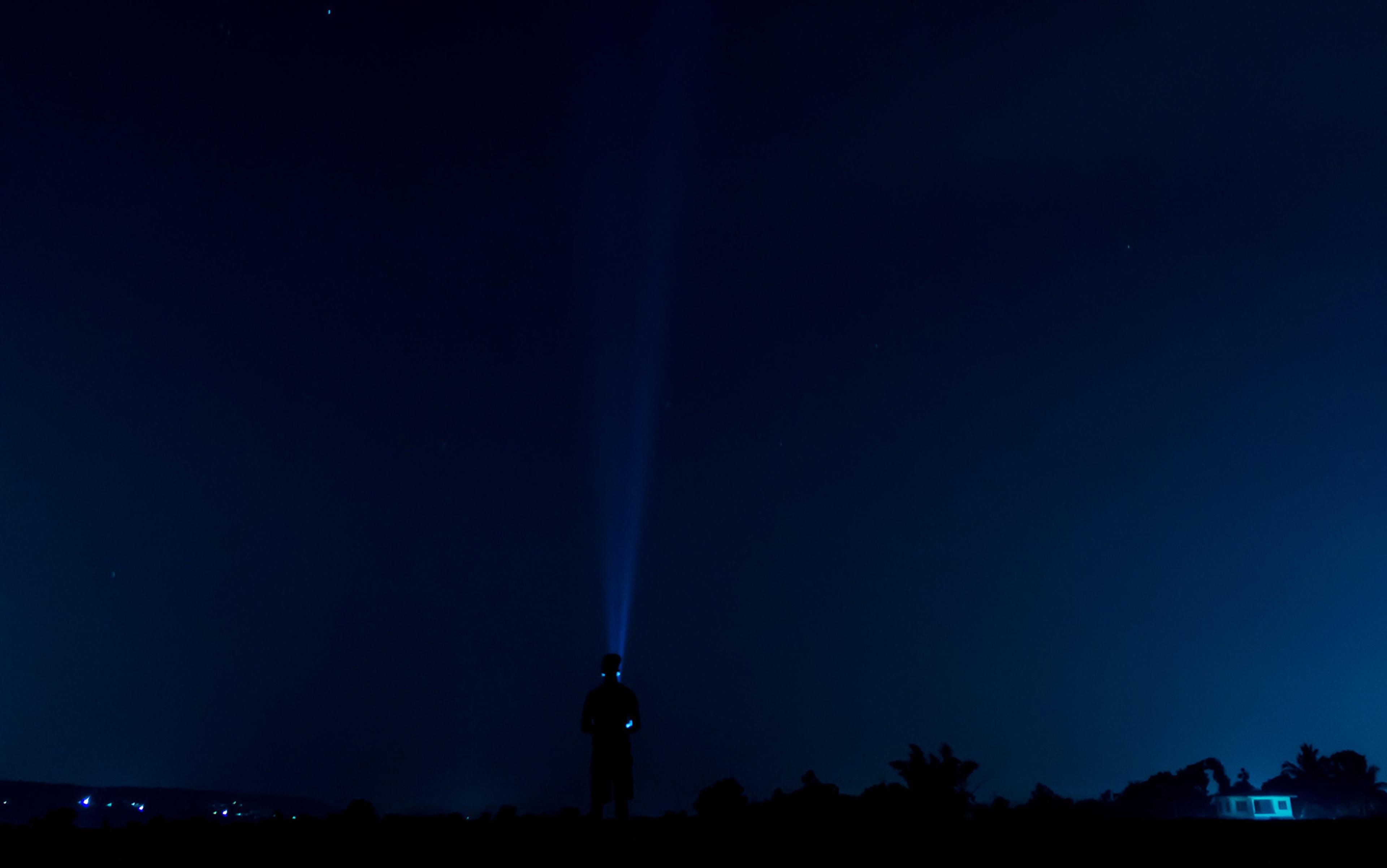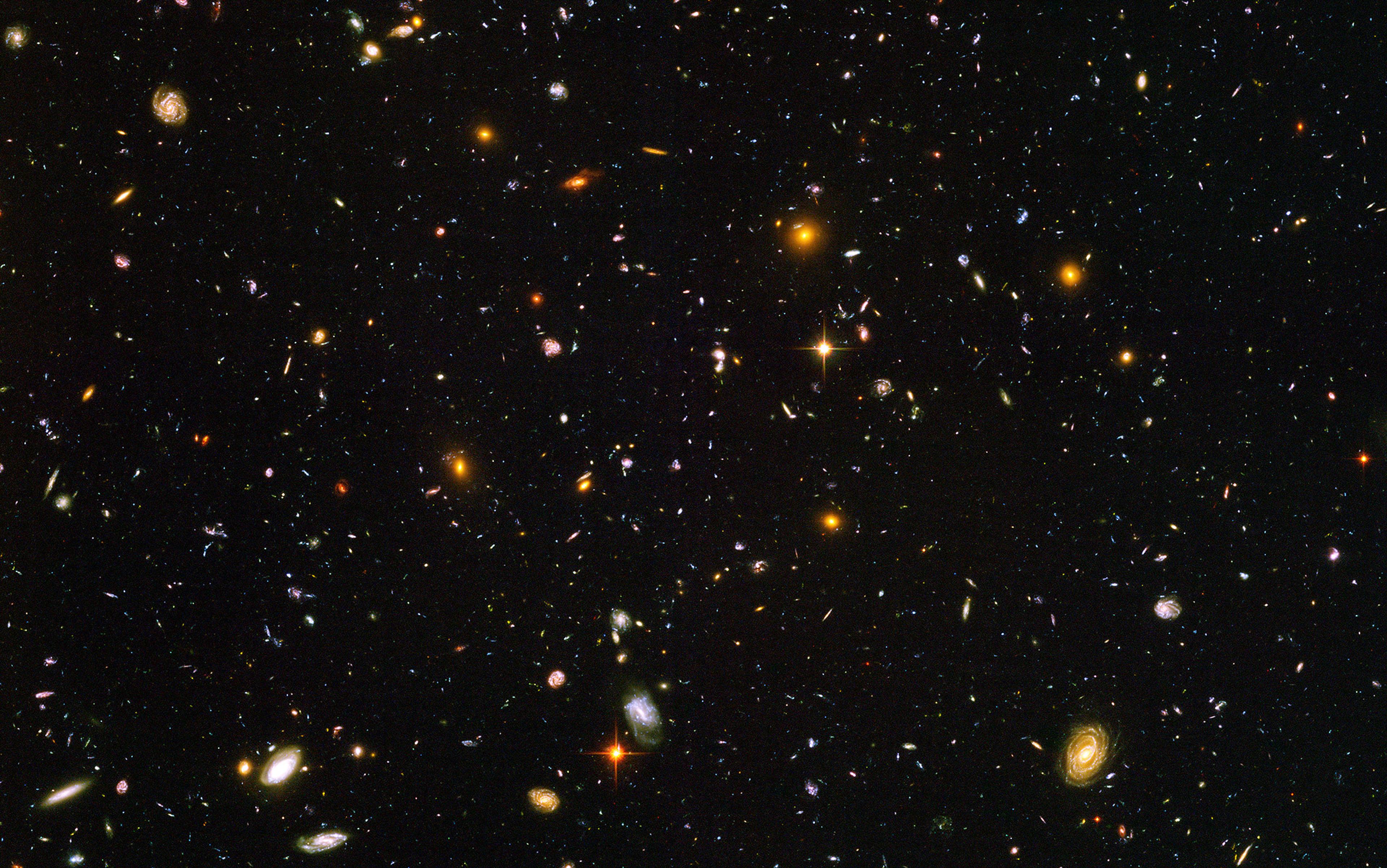The human eye, that great enabler of art and action, has some galling design limitations. Our vision is tightly tuned to the peak colours of sunlight, leaving us blind to almost all other forms of radiation. If you think about the frequencies of light by analogy with the frequencies of sound, there are some 80 octaves of detectable electromagnetic radiation found in nature. We are able to see exactly one of them: the octave that extends from the violet to the red ends of the rainbow. The Universe bombards us with the other 79 octaves all the time, but we are oblivious to them.
The human mind, on the other hand, suffers no such limitations. Technology can create sensors responsive to rays that are utterly inaccessible to the human eye, or to any other type of eye found in the biological world, for that matter. Venturing even a tiny bit beyond the red edge of the rainbow, into the undiscovered country of the infrared, is a transformative experience: it reveals an entire hidden Universe, a previously walled-off layer of reality that we are now exploring every day as results pour in from the James Webb Space Telescope (JWST).

Photo by Diego Augusto Lima
From its perch a million miles from Earth, JWST has spent the past three years scanning the sky in infrared radiation, sensing light waves that are up to 40 times longer than the reddest red that we humans can see. All of the glorious pictures that the telescope sends back – scenes of galaxies in collision and infant stars spewing out streamers of gas – are not photographic snapshots so much as they are data interpretations. JWST perceives celestial shapes and colours that exist only within the circuitry of its digital detectors. Astronomers then use software and imagination to translate the detectors’ electrical impulses into images we can comprehend.
Every fresh result from JWST, then, is a showcase of the technological evolution of our species. The largest, most complex observatory ever sent into space is also the largest, most complex bionic eye ever wired into our consciousness. It is the culmination of a two-century effort to tear off our evolutionary blinders and endow Homo sapiens with senses that are as expansive as the laws of physics allow.
JWST is a floating catalogue of everything that astronomers have ever learned about telescope making. It follows a blueprint laid out in a 1988 report from the US National Research Council, which endorsed a giant new space telescope that ‘would lead to a quantum leap in our understanding of some of the most fundamental questions in astronomy’, supported by $10 billion of subsequent funding.
The resulting instrument peers out at the cosmos using a 6.5-metre-wide mirror composed of 18 interlocking hexagons, fabricated from lightweight beryllium metal and coated with 48 grammes of super-reflective pure gold. Together, those mirrors take in a million times as much light as the pupil in your eye. The collected rays then focus on 15 mercury-cadmium-telluride detectors and three detectors made of arsenic-doped silicon, which act as JWST’s infrared-tuned electronic retinas. The whole telescope huddles behind a 21-metre-wide Kapton sunshade that keeps it chilled to 233 degrees below zero Celsius; even a trickle of solar heat would ruin its hypersensitive vision.
Everything about JWST is up to the minute. But the underlying technology, and the whole ‘seeing in the dark’ agenda that inspired it, follows directly from the work of the British astronomer William Herschel more than two centuries earlier. In particular, it follows from a revolutionary but deceptively simple experiment that Herschel performed using nothing more than a prism, a box and three mercury-bulb thermometers.
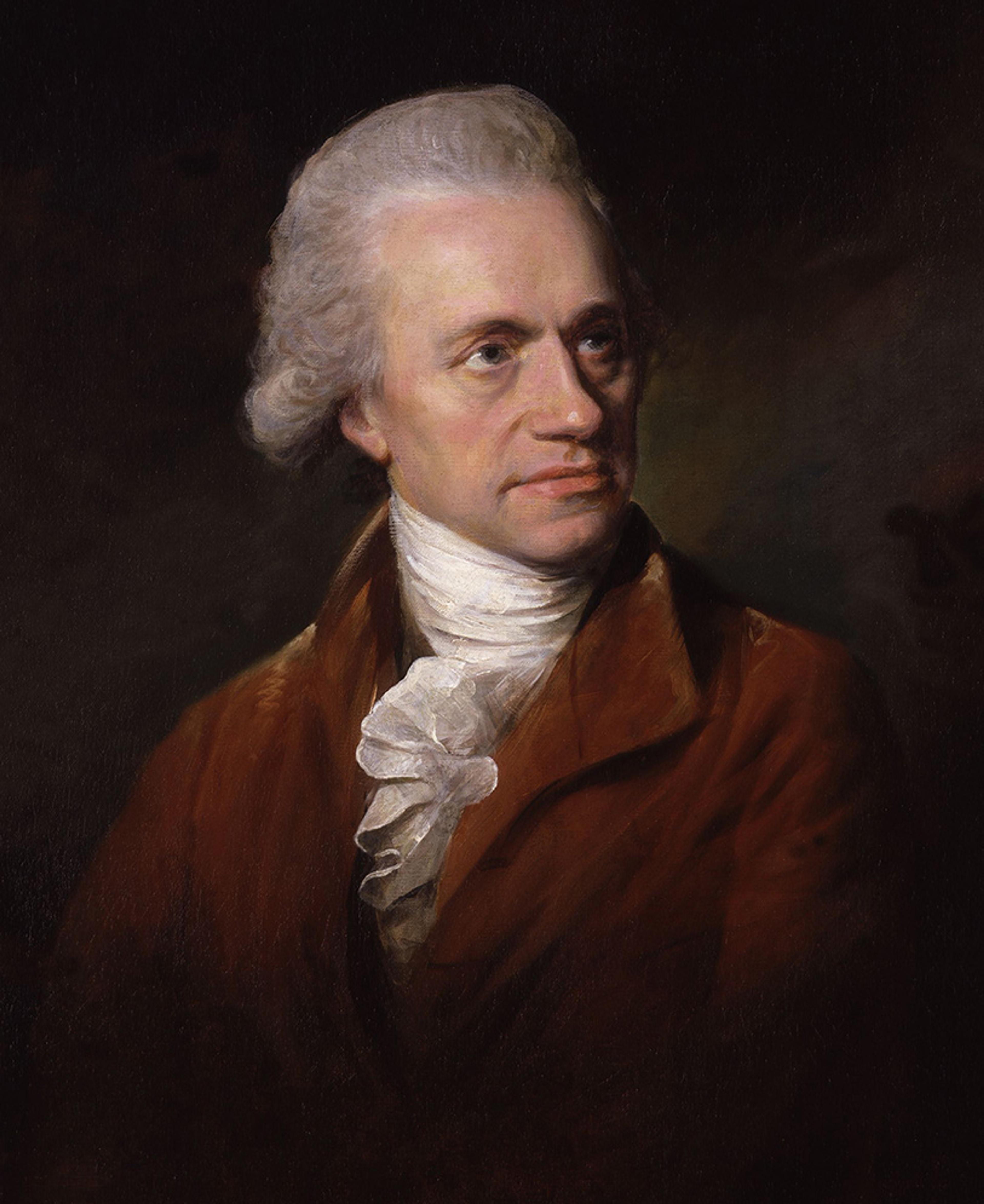
William Herschel by Lemuel Francis Abbott c1785. Courtesy the NPG London
Today, Herschel is best remembered as the man who discovered the planet Uranus in 1781. That achievement alone would be enough to earn him a star on the history-of-astronomy walk of fame. There was much more to him, though. He was an accomplished instrument-maker who built the largest telescope of his age. He performed the first serious attempt to map our home galaxy, the Milky Way. He speculated on the nature of life on other worlds (even, he suggested, on the Sun). And, starting in early 1800, he carried out a series of experiments that culminated in the detection of rays that carry a warming effect even though they are invisible to the eye.
In modern terms, Herschel discovered infrared rays, and the entire unseen Universe that they signify.
This sweeping discovery was born out of simple, stubborn frustration. Annoyed by having to write off half of his potential observing hours, Herschel wanted to extend his celestial investigations into the daytime and study the surface of the Sun. But his huge telescopes, ideal for viewing dim stars at night, were far too powerful to handle the brilliance of solar rays.
Herschel had discovered a new type of ray: undetectable to the eye, warmer than visible light, and redder than red
Herschel began testing various types of filters that would let him look at the Sun without frying his eyes, when he noticed a perplexing disconnect. ‘[W]hen I used some of them, I felt a sensation of heat, though I had but little light; while others gave me much light, with scarce any sensation of heat,’ he wrote in a paper read before the Royal Society on 27 March 1800 in Somerset House, London. He recognised that his finding carried two huge, intriguing implications: certain types of rays were capable of transmitting heat, and some of those rays were somehow different from the types of light rays that stimulate vision in the eye.
Now Herschel had a juicy mystery to solve: what were these unseen rays? Did they bend through a prism, like ordinary light? If so, did they correspond to the colours of light in some way? Herschel being Herschel, he passed sunlight through his prism, cast a rainbow, and measured the temperatures within the different colours. A clear pattern emerged as he moved from the violet to the red end of the prismatic spectrum. Green light produced more warming than blue; red produced more warming than green.
Which made Herschel wonder: What if? What if he kept going beyond the red, where there is no visible light at all? What would he find there?
Herschel’s initial journey into the invisible Universe extended all of four inches (10 cm) across his tabletop apparatus, but they were four extremely significant inches. He updated his Sun-filter experiment, relocating his thermometers to the seemingly dark zone past the red edge of the rainbow that beamed from his prism. There, to his delight, he found that the instruments continued to register heat, even where his eyes registered nothing.
When Herschel took the readings from his thermometers, he determined that the warming caused by the Sun’s rays not only continued beyond the red zone, but the effect actually intensified as he ventured deeper into the darkness past the rainbow’s edge. He had to move his thermometers far outside the visible spectrum before the warming effect peaked and then tapered off. Evidently, he was measuring a rising and falling distribution of some phenomenon that existed beyond the human senses. It was as if he were running his hands over the arched back of an invisible cat.
To be methodical, Herschel also poked around at the other end of the spectrum, past the violet edge. There he found no warming effect, confirming his inference: he had discovered a new type of ray emitted by the Sun, one that is undetectable to the eye, warmer than visible light, and (illogical as it sounds) redder than red. On 24 April 1800, he relayed the results of his investigations to his Royal Society colleagues.
It is impossible to know what Herschel was feeling at the time, but in yellowed pages of the 225-year-old volumes of Philosophical Transactions of the Royal Society, he seems to be bursting with excitement. Normally, he confined himself to sober notations of his empirical observations, and shied away from extravagant speculations. In this case, though, he seemingly could not hold back an outpouring of ideas.
In his two presentations to the Royal Society, Herschel introduced an entirely new scientific vocabulary. On 27 March, he coined the term ‘radiant heat’. A month later, he distinguished between the visible colours that he could see and the invisible ‘colours’ that he could only feel based on their warmth, calling the former the ‘prismatic spectrum’ and the latter the ‘thermometrical spectrum’.
Most perceptively, Herschel realised that the two types of rays he was examining must have one and the same fundamental nature. Applying the principle of parsimony, he rejected the existence of ‘two different causes to explain certain effects, if they may be accounted for by one’. The difference between the two types of rays, he deduced, was merely that the human eye could perceive one type of ray, but not the other. He concluded that ‘radiant heat will at least partly, if not chiefly, consist, if I may be permitted the expression, of invisible light.’
We limited human animals see only what we need to survive
Invisible light. What a concept! The invention of the telescope had proven that there are objects too faint to be visible to the unaided human eye – but when their light is concentrated, they pop into view. The invention of the microscope had likewise demonstrated the existence of objects too small to be seen – but when they are magnified, they, too, pop into view. Herschel had revealed a more fundamental limitation of human perception. His ‘thermometrical spectrum’ indicated that some portion of reality is invisible to us not because it is lacking in quantity (size or intensity, say), but because of its essential quality. The scope of Herschel’s intellectual breakthrough was all the more remarkable given the modesty of the technology that enabled it. If you want to recreate the Herschel experiment yourself, you can find simple, step-by-step instructions online.
In Herschel’s culminating experiment, presented to the Royal Society on 6 November 1800, he produced a ‘spectrum of heat’, showing how his measured temperature varied with distance from the red end of the visible spectrum. It was, in essence, a line drawing of his invisible cat. In an earlier paper, he had even offered what a modern scientist might call an evolutionary explanation of why much of the Universe is invisible to us:
admitting, as is highly probable, that the organs of sight are only adapted to receive impressions from particles of a certain momentum, it explains why the maximum of illumination should be in the middle of the refrangible rays; as those which have greater or less momenta, are likely to become equally unfit for impressions of sight.
Plainly put, we limited human animals see only what we need to survive.
It might seem inevitable that Herschel would then have embarked on more expansive investigations of light-beyond-light, or at least that other researchers would have taken on such an agenda. In reality, Herschel’s investigations were soon hindered by the crude thermometers available to him, which were accurate only to about half of a degree. Creating any kind of image or snapshot of the beyond-red realm was impossible using such simple devices. Herschel was limited, too, by the prevailing theories of the time. In the early 19th century, most scientists thought of light as a shower of particles, and heat as a movable fluid called ‘caloric’.
Herschel sounds increasingly defeated in the succession of papers that he presented to the Royal Society through 1800. By May of that year, he had sourly confessed that ‘the termination of a prismatic spectrum cannot be accurately ascertained.’ He had no desire to be drawn into contentious arguments about the nature of heat. Herschel was an empiricist by nature, and his great aspiration was to be the supreme celestial cartographer. When he realised that he could not map the boundaries of his new invisible landscape, he returned to the more accessible challenge of mapping stars and nebulae.
And there the story of the unseen Universe stalled for a long, long time. What Herschel had achieved was not so much a scientific revolution as something both bigger and less well defined: a slow-moving perceptual transformation. Peering into the infrared world required the development of entirely different sensory technologies, ones that could take us well beyond what our organs of sight are adapted to see.
Charles Piazzi Smyth, Scotland’s Astronomer Royal, made an incremental but meaningful advance in 1856, more than three decades after Herschel’s death. He detected infrared rays from the Moon using a thermocouple, a then-novel type of thermometer that measures temperature based on the way that electricity flows through two adjacent conductors. It seemed logical that the Moon must reflect invisible heat rays from the Sun, but Smyth had delivered hard evidence. More profoundly, when he performed his measurements at various points on Mount Guajara in Spain, he found that the infrared Moon appeared dimmer at low altitudes. Whatever these beyond-red rays were, they were evidently absorbed by Earth’s atmosphere.
Wood’s technique revealed Herschel’s ghost realm, a place where the sky is dark and trees glow with eerie infrared reflections
Each subsequent sensory advance was similarly hard-won. Starting in the 1870s, the astronomer and aviation pioneer Samuel Pierpont Langley invented the bolometer (a more precise type of electronic thermometer) and used it to map the Sun’s infrared spectrum for the first time. In the 1910s, the physicist William Coblentz strung together multiple thermocouples to create a ‘thermopile’ capable of detecting infrared rays from stars, planets and nebulae as well. That same decade, the inventor Robert Williams Wood combined recently developed, infrared-sensitive film with a special filter (‘Wood’s glass’) that completely blotted out visible light. In this way, he managed to photograph terrestrial landscapes in infrared rays.
Wood’s technique worked only in broad daylight, using extremely long exposures, but it finally revealed Herschel’s ghost realm. It exposed the scenery of the infrared world, a place where the sky is dark and trees glow with eerie infrared reflections.
Hoping to extend infrared vision into deep space, researchers trekked to the tops of mountains, above the bulk of Earth’s atmosphere, wielding new electronic lead-sulfide detectors, which were far more sensitive than film. So equipped, the astronomers Gerry Neugebauer and Eric Becklin achieved the next great perceptual leap in 1966. Using a custom-built telescope situated atop Mount Wilson in California, the two surveyed the infrared sky. In the constellation Orion, they spotted an unidentified glow – something that was bright in infrared but completely invisible to conventional-light telescopes.
The ‘Becklin-Neugebauer object’ is now believed to be a massive infant star, cloaked in a cocoon of dusty gas that blocks all of its visible light but not the more penetrating infrared rays. It was the first celestial object ever discovered in infrared radiation alone.
Even then, the study of infrared rays from space remained a tedious, fringe area of research. All the early explorers of the invisible faced the same limitation: they could trek to mountaintops, loft balloons, or even peer out through a hole in the fuselage of a C-141A jet transport plane (seriously, they did that), but they were still hampered by the thick murk of our planet’s infrared-blotting atmosphere. Infrared astronomy did not take flight until it could literally take flight, using the rockets of the space age.
In 1983, the United States, United Kingdom and Netherlands teamed up to launch the Infrared Astronomical Satellite (IRAS), the first true infrared space telescope. It circled Earth in a near-polar orbit, 900 km (560 miles) above the ground. In a mere 10 months in service, IRAS detected 350,000 infrared sources, and opened our eyes to an entirely unknown side of the Universe. It spied wispy ‘cirrus’ clouds of gas and dust between the stars, and warm disks around young stars, revealing the birthplaces of new planets.
Reporters wrote up breathless stories when IRAS recorded the mysterious glow of a possible Jupiter-sized world lurking just beyond our solar system. ‘All I can tell you is that we don’t know what it is,’ said Neugebauer, who by this time was the chief scientist for IRAS. Further analysis revealed that the object was not an Earth-threatening planet but a star-studded galaxy: a glimpse at the previously unknown way that galaxies flare up with newborn stars when they slowly, powerfully crash into one another.
Each new type of observatory has yielded a new human familiarity with another layer of previously hidden reality
JWST is a majestic elaboration of IRAS’s achievements, extending our infrared gaze to the literal ends of the Universe. It is an elaboration, too, of the motivations that guided Herschel’s work. His greatest goal as an observer was what he called ‘gauging the heavens’. He attempted to catalogue every visible star in the sky and estimate its distance, with the intent of mapping the entire Universe. JWST’s expansive infrared vision is now bringing us close to the completion of that task.
We live in an expanding Universe, which means that visible light from extremely distant galaxies is stretched deep into the infrared. The early history of the cosmos is secreted away in those hidden rays, inaccessible to telescopes on the ground. JWST’s detectors are specifically designed to bring stretched infrared light into view, seeing back to the historic moments when the first galaxies lit up. One of JWST’s sightings – a galaxy designated JADES-GS-z14-0 – is the most distant object known to humanity. We are observing this galaxy from a time 13.4 billion years ago, when the Universe was just one-50th of its present age.
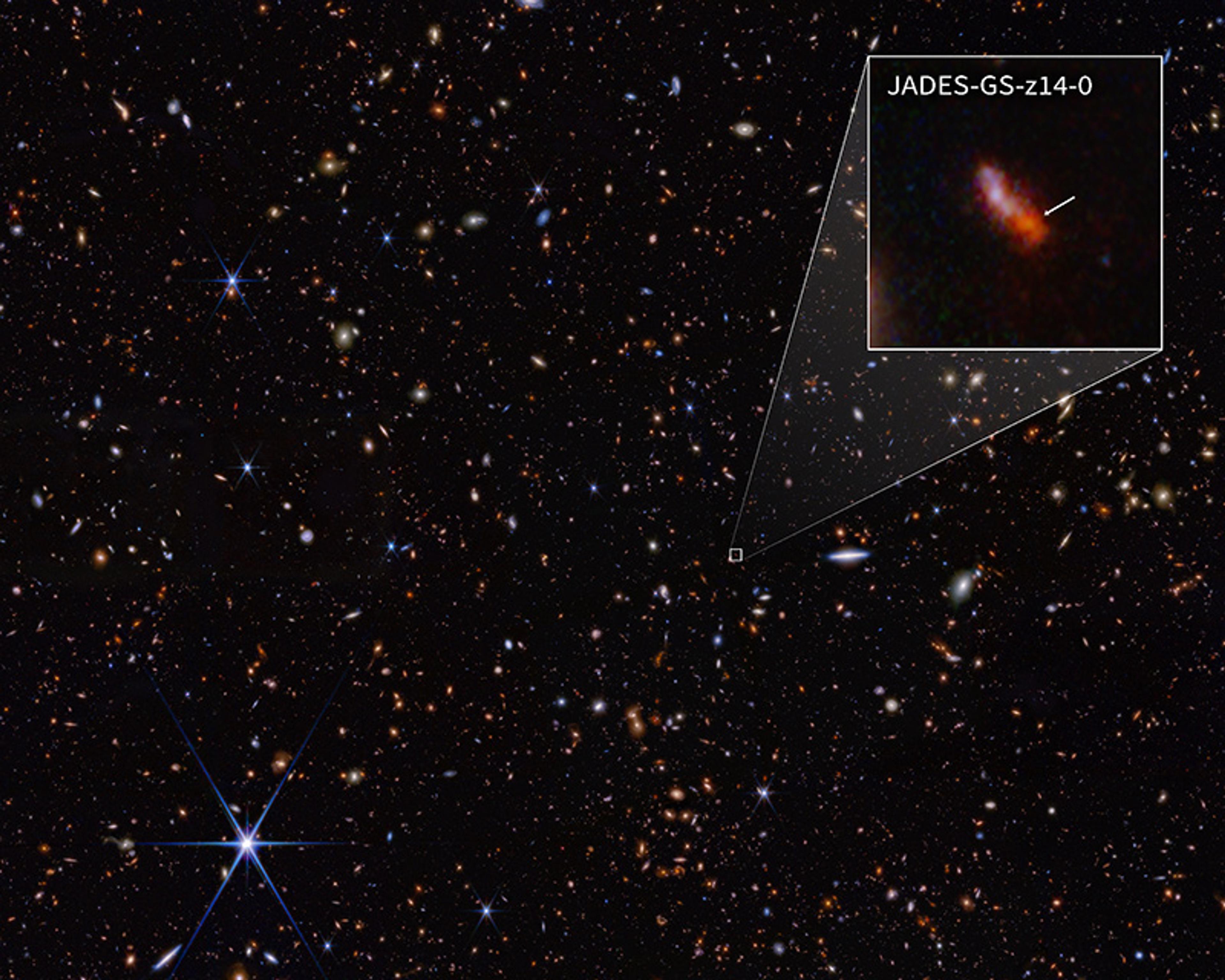
Observed by the James Webb Space Telescope, the JADES-GS-z14-0 is the current record-holder for the most distant known galaxy. Courtesy NASA, ESA, CSA, STScI, B Robertson (UC Santa Cruz), B Johnson (CfA), S Tacchella (Cambridge), P Cargile (CfA)
What’s remarkable is not just that we can see such a thing, but that we can recognise what it is and make sense of it. Astronomers are already analysing the invisible light from this infant galaxy, studying its composition, assessing the glow of its youthful stars. Teams from NASA and the European Southern Observatory put out press releases. News outlets around the world noted the discovery. The detection of invisible light from the edge of the known Universe registered as an exciting yet routine advance in astronomical exploration.
In 1998, the philosophers Andy Clark and David Chalmers proposed a radical understanding of cognition that could take the new realm into account. In it, they argued that human thought doesn’t end at the skull but extends into the tools and environment around us – including our technological surroundings. They called this framework the ‘extended mind’. As an example, they described a person interacting with a computer screen displaying geometric shapes. The individual doesn’t just perceive the shapes; they mentally manipulate them – rotating, moving, imagining them – as though the objects were physically present. In this way, person and machine form a ‘coupled system’, with the digital shapes becoming part of the individual’s cognitive landscape.
Seen through this lens, JWST becomes more than just a distant observer. The stream of infrared data it captures can be considered part of our evolving awareness of the cosmos. Its detectors expand our sensory reach; its images of ancient galaxies reshape our inner mental world; and its vast archive, stored in Baltimore, Maryland, functions like an external annex to human memory. Even if one doesn’t fully embrace the Clark-Chalmers hypothesis, the implications remain striking: JWST can be understood as a sensory prosthesis – like a retinal or cochlear implant – not just enhancing perception but becoming part of how we know.
Patients who receive such implants adapt to them rapidly, their brains assimilating synthetic inputs alongside the biological ones. No wonder, then, that astronomers and the lay public alike have no difficulty identifying the form and the significance of an object like JADES-GS-z14-0. Our minds adapt just as readily to inputs carrying information from the invisible fringes as they do to inputs describing ordinary light and sound. The extension of the human senses, begun by Herschel with his humble prism-and-thermometer experiment, has since continued to gamma rays and radio waves, and even beyond radiation into neutrinos and gravitational waves, both of which are now within our technological sights. Each new type of observatory has yielded a new human familiarity with another layer of previously hidden reality.
Clark and Chalmers pointedly expressed what happens as technology expands our senses and breaks away the barriers of human perception: ‘once the hegemony of skin and skull is usurped,’ they wrote, ‘we may be able to see ourselves more truly as creatures of the world.’
This Essay was made possible through the support of a grant to Aeon Media from the John Templeton Foundation. The opinions expressed in this publication are those of the author and do not necessarily reflect the views of the Foundation. Funders to Aeon Media are not involved in editorial decision-making.

